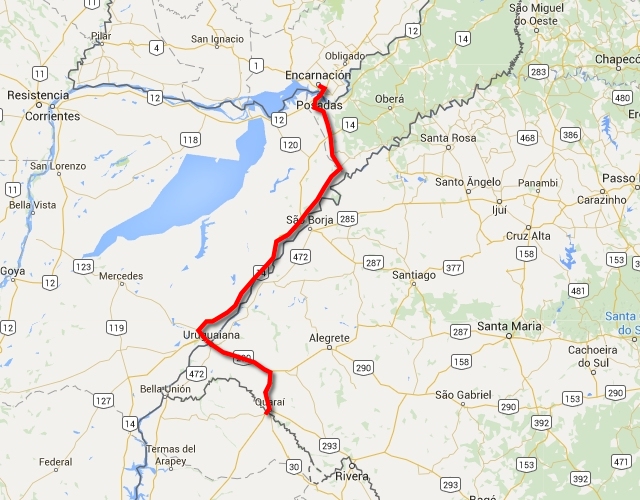
Nothing compares to the simple pleasure of a bike ride. J.F.Kennedy
Search this website
Direction Uruguay
Encarnatión, Posadas, Apostoles, Santo Tomé, Alviel, Paso de Los Libres, Uruguaiana (Brazil), Quaraí, Artigas (Uruguay)
To reach the bridge over the Paraná River, I had to cycle a few kilometers through the city. I searched for an Exchange office to exchange my remaining guarani, but could not locate one in that traffic. At the passport control office, I received an exit stamp without any problem, at the same booth where motorcyclists were showing their ID cards. I asked about an Exchange office, and was told it was located in the toll building. Equipped very modestly – a table, a man with a calculator and a pocketful of money. The exchange rate, however, was the same as in the luxury Exchange office in Ciudad del Este. He even exchanged my remaining coins, which was quite unusual.
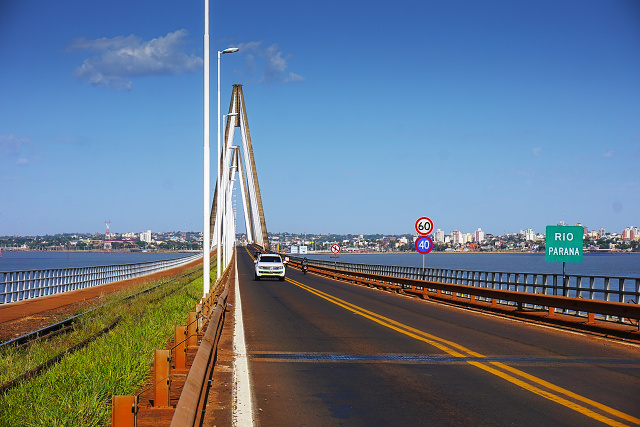
Bridge between Encarnatión and Posadas: Only a two-lane road, pedestrians must take a train along track on the left
The bridge was surprisingly empty, pedestrians were denied entry and had to take the highly frequented train. About one kilometer before the Argentinian side, a line had started to form. I happily passed everyone. It seemed to take a long time as some drivers, in order to save on gas, were pushing their cars forwards with their bare hands. However, even the line for motorcyclists turned out to be quite long, so I overtook them, too. I entered the border booth, thanked them loudly and shortly afterwards entered Argentina. See the photo of motorbikes in front of the border office with the blue sign: "Malvinas are Argentinian". Well, a long-lasting trauma.

Bridge between Encarnatión and Posadas: There are ways of saving - drivers pushing their cars in the line to passport control
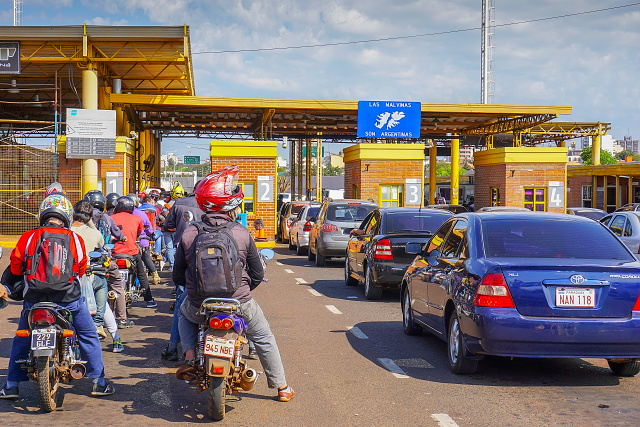
Posadas : Line at passport control
Posadas
I had quite a lot to do, so I decided to stay in Posadas. I located a campsite on my GPS about 5 km from the city center, but it was closed. I tried the Guatambae Hostel, they only had a vacancy in a shared dormitory. I asked about their garden, where I could camp in my "carpa". Spot-on! For 120 pesos I was accommodated in the hostel garden.

Posadas : Church on the periphery
I headed for the 3-km distant center, with three tasks to accomplish – get hold of a road map, a gas canister for my stove and withdraw cash from an ATM. I had to admit that it did not go so well. None of the bookstores had any maps, not even the tourist office, or any of the many gas stations. I eventually found the gas canister in a specialized outdoor store, which was open long after the official 16:30 (they have siesta there and usually I was stupidly cycling during this time). Stores, except the big shopping malls, were open during the morning hours and then again in the evening. Not sticking to the opening hours is a rule.
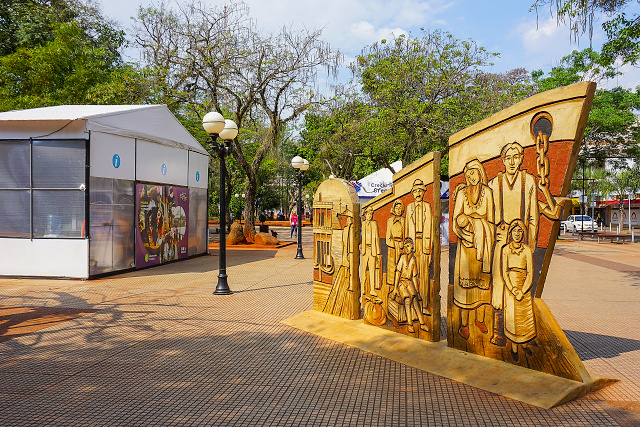
Posadas : 9 de Julio square - constructive fresco

Posadas : 9 de Julio square - no optimism radiates from the Madonna

Posadas : 9 de Julio square - Cathedral
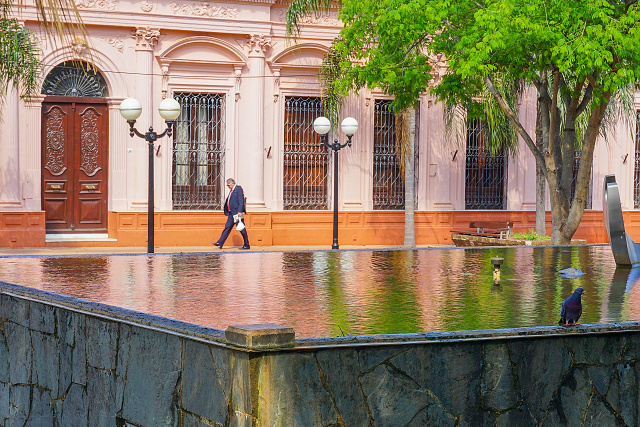
Posadas : 9 de Julio square – Judicial Palace
Financial Woes
The withdrawal of cash was a hopeless task. Not even one of the six ATMs located in the bank building would spit out any money. On the contrary, an ATM ate my card! I did not have my phone with me, I did not even know if it functioned in Argentina. I stopped an Argentinian and asked him to call the displayed number for me. There I only found out that I was to go to the bank "maòana". Right, when I had been pleased the day before that the double payment in Asunción had finally been resolved.
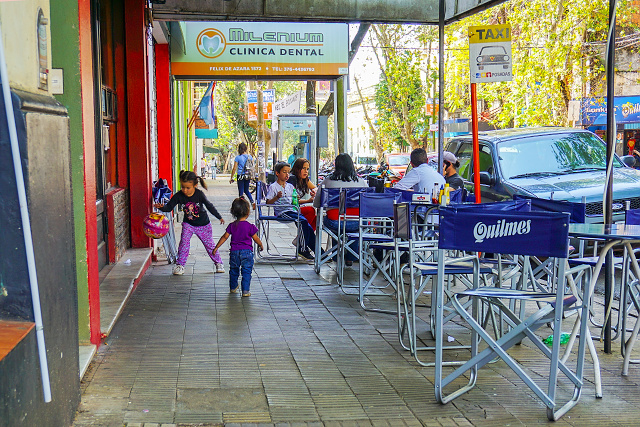
Posadas : Busy streets
I shopped in a supermercado, prices were noticeably higher there than in Paraguay. However, prices of wine and hard alcohol were markedly lower, so I knew what would keep me going if I needed to save money. I paid for the purchase with my second (and last) card. They had some issues with chip cards, I had to go to an office with the manager, but it worked the second time.

Posadas : Shopping mall
As always, I slept well in the tent, packed up everything quickly and, full of courage, headed to the bank on 9 de Julio Square. I was there at 08:00, the time they opened, but also already 8th in line. I locked my bicycle next to a tree at a taxi stand, where the drivers looked after it. After half an hour's wait, I reached the client office, explained my problem in my broken Spanish, and a few minutes later was already caressing my rediscovered credit card. I asked the employee to assist me with a cash withdrawal. We did everything as we should, but the money was not coughed up — it claimed that I had exceeded the daily limit.
I could not leave without any cash, considering it would be even worse in smaller towns. I started again to visit banks and always asked which ATM I could use for my Visa card (MasterCard was totally out of the question). I finally succeeded at the Patagónia Bank, where one out of the six ATMs released at least 1000 pesos (about CZK 2700, $135). It refused to pay out any more than that. I thus lined up one more time at this ATM (lines at ATMs are the norm there) and withdrew another 1000 pesos. This resolved my survival crisis for several days.
I did not get hold of a proper map, only a schematic road plan. I chose the route via San Carlos, which appeared to be the shortest. And it really was, except, after the first 20 kilometers, the asphalt road turned into a dust one covered in the typical red clay. I did not want to suffer through another 50 km on it, so I cycled around it on Roads 12 and 105. I realized that a proper map was a must. I stopped at every gas station and succeeded at the 4th one, where I purchased a map of the local area, as well as of the whole of Uruguay for 80 pesos.
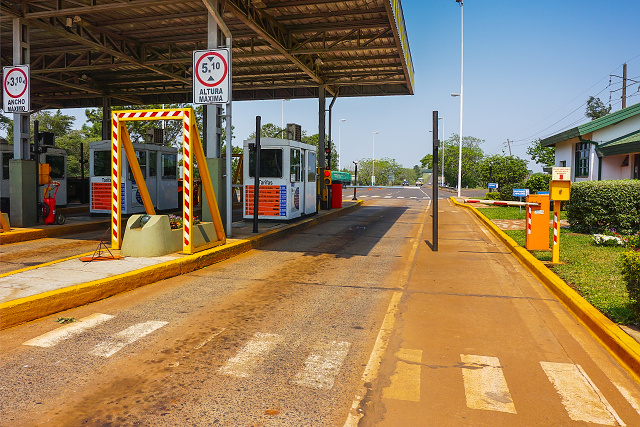
Road 105 N of junction with road 14: Tollgate, motorbikes and bicycles have free passage on the right
Just as in Paraguay, a fee was charged for the main roads. I felt exceptional when passing the toll gate. I passed through it via the short line for motorbikes, free of charge. I filled up on cold drinking water. There was even a water boiler with hot water for making Mate on the wall of the building. I did not have the loose leaves of Yerba Mate, which are normally used, but normal teabags of Mate cocido. Nevertheless, I understood that drinking warm Mate in that heat (max. 45 degrees, average 30 degrees) was the best one could do for the body.
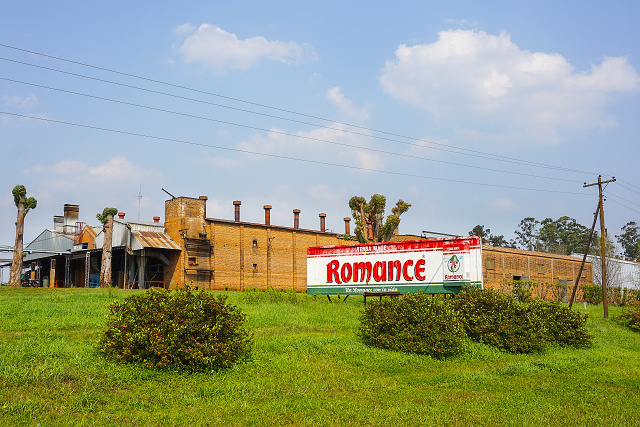
N of Apostoles: Romance factory for Yerba Mate
At the intersection of Roads 105 and 14, I had to make a decision which way to take. I located campsites on the GPS. Four of them were near Apóstoles city, which is asserted to be the Mecca of Argentinian Mate. I did not expect any of the campsites to be open. I was right. Then I cycled around Apóstoles for about an hour, searching for accommodation. Just when I was ready to give up, leave the city and sleep somewhere in the wild, I found accommodation in the only hotel in the city.
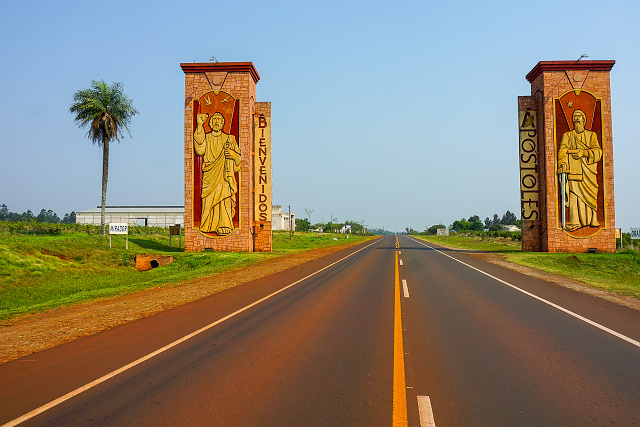
N of Apostoles: Gateway to City of Apostoles - St Peter and Paul
An interesting problem had arisen with the GPS. I changed the battery and suddenly no map was displayed. It refused to navigate, it had a total breakdown. The correct settings with the right map were selected. I checked whether the memory card was inserted properly. It was not there at all, it had fallen out when changing the battery and lay in the dust at my feet. So, once again, at the last moment I won, through my own stupidity.

Apostoles: Garden decoration
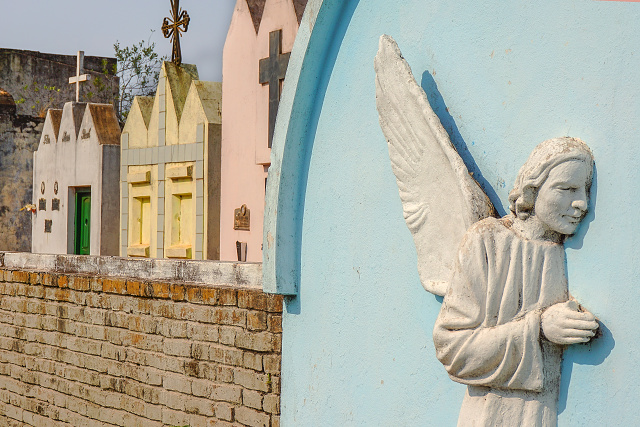
Azara: Cemetery
I slept relatively well in the hotel. The breakfast was quite bad – four slices of dry bread, butter, marmalade, coffee. I did not try to make it any easier for myself, I got going directly without searching for any more food. I passed through Azara city and suddenly faced a broken asphalt road ahead of me, replaced several times by a dirt road.
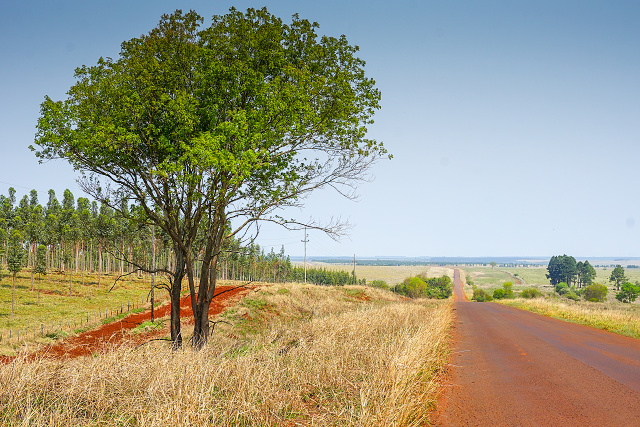
30 km S of Azara: Roads with minimal traffic
Although parts of the road were asphalted, it was badly damaged. The road disappeared totally several times and then was badly destroyed. However, there were some advantages to this. On those 60 km I encountered only about 25 cars. I could do whatever I liked and cycled in the middle of the road without having to monitor the traffic in the rear-view mirror all the time. There were forests beside the road, many birds, especially birds of prey hunting in pairs. The only downside was that my clothes got dirty from the dust and I would have to wash them very soon to look decent.
90 km later, I arrived in Santo Tomé city, located beside the Uruguay River, which formed the border with Brazil. On the edge of the city, there was a bridge into Brazil. I located a freely accessible town campsite beside the river. Camping was possible, but there was no running water. The toilet was destroyed and, in addition, local youngsters had their hangout there. I had to wash the dirt from myself, so I gave up and located the cheapest hotel in the city (there were four in total, two of them were very expensive).
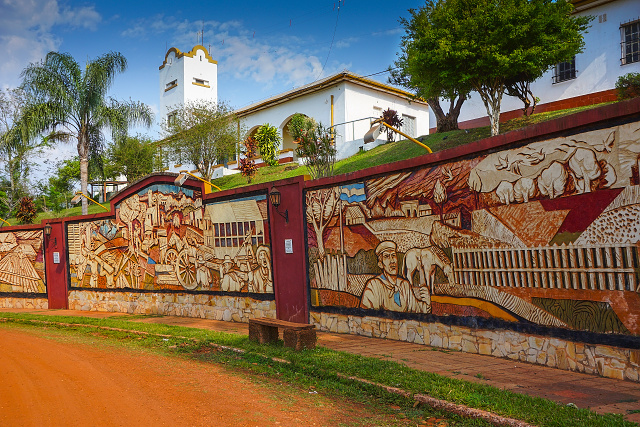
Santo Tomé: Church above Uruguay River
The city had its charm. I especially liked the original colonial houses, although they were no longer in mint condition. Other good news was that the ATM at the National Bank allowed me to withdraw money, even though it was again only 1000 pesos at one withdrawal. I used it twice, to have enough cash for the following days.
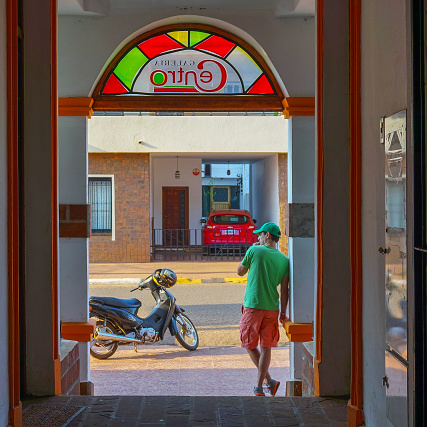
Santo Tomé: In the center
I found a restaurant which opened at 20:00. This was the norm there. I ordered a chunk of meat with rice, salad and beans, together with two deciliters of red wine and I was content.
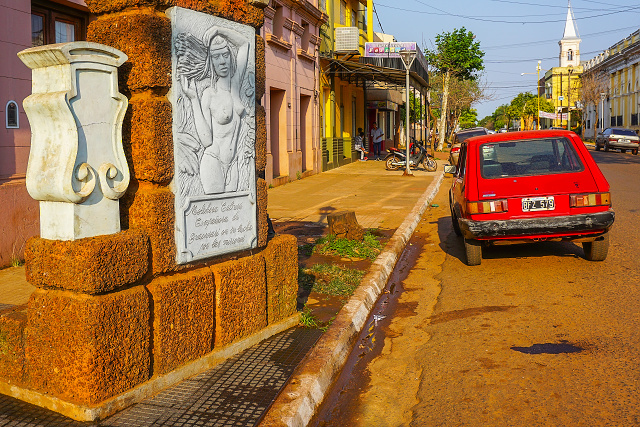
Santo Tomé: Reliefs along Avenida St. Martín
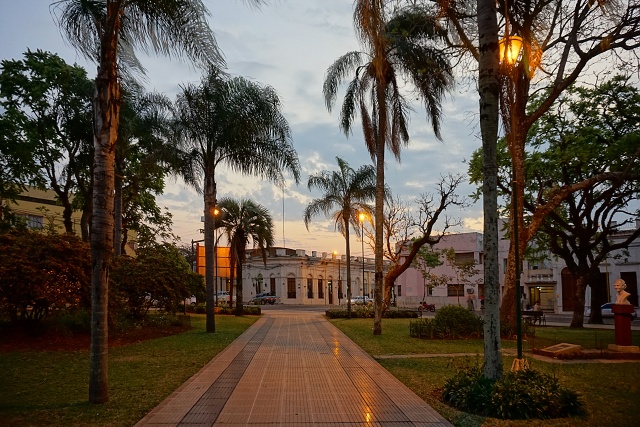
Santo Tomé: Square at dusk
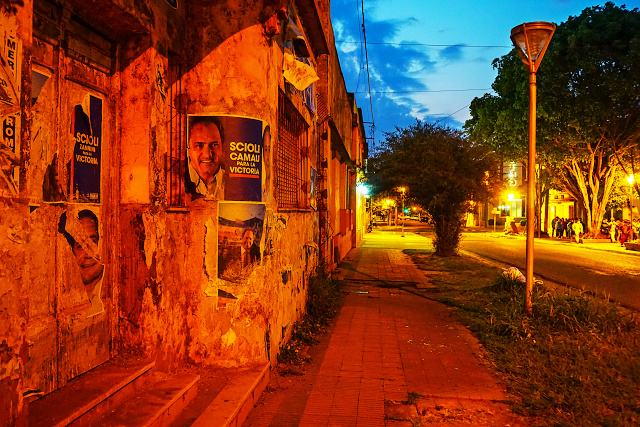
Santo Tomé: Election posters
I felt sorry for my heavily tested bicycle and, the following morning, sprayed at least the main parts with WD, oiled the chain and inflated the tires. I passed through the city on to Road 14 and was happy to have avoided that road the previous day. The verge was overgrown with grass, unsuitable for cycling. Heavy traffic, many trucks. I constantly had to monitor the traffic in the rear-view mirror and sometimes give way to trucks and go on to the bumpy verge. There was no pleasure in cycling, although it was cloudy and therefore no sweat.

20 km S of Santo Tome: The landscape is still the same – unimpressive
The strong wind insisted on blowing from the 9 o'clock direction and at other times became a massive headwind from 11 o'clock. The countryside was invariably uninteresting, wide grassy pampas on which cattle were grazing. It only got slightly undulating before Alvear, with some small hills.
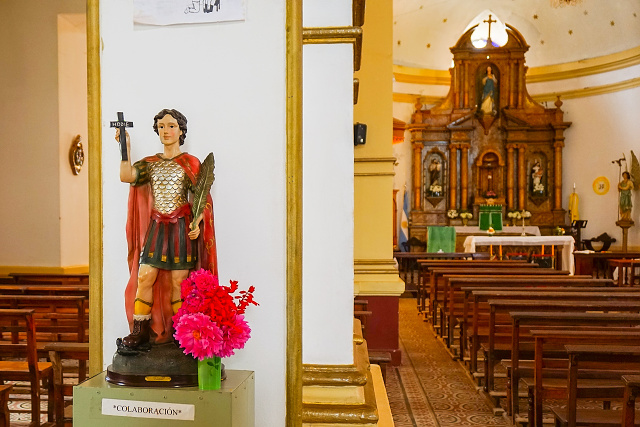
Alveal: Church interior
I stopped after 90 kilometers in the small town of Alvear. I had to ring the local hotel owner, who was enjoying his siesta and sleeping in the adjacent house. I forced the bag of dirty clothes on to him for washing, although he tried to resist, saying the sun was not shining and therefore it would not dry until the following morning. However, there was a strong wind blowing and, if it wouldn't rain, I could wear clean clothes the following morning. The WiFi, advertised on the hotel wall, was not functioning. Apparently a lorry had pulled down the telephone wires. I wondered if there was any truth in that.
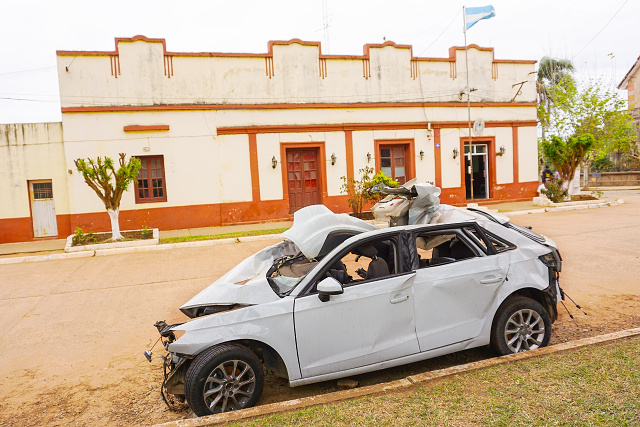
Alveal: Deterrent wreck outside police station
I was fascinated by the stores in the town of 8000 inhabitants. No big food store, only some "garage" kiosks with a limited selection on their 10 to 25 square meters. I somehow could understand three stores of a national lottery, but 20 stores for shoes, small clothing items, and jewelry really surprised me. Someone must be buying that stuff, otherwise those one-roomed stores would have closed down. And it was 100 km to the nearest big city.
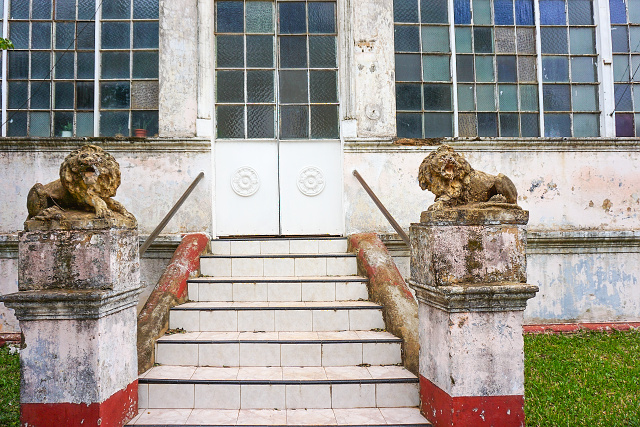
Alveal: Facade of a once palatial house
Probably when the farmers came into town to spend some money, they purchased some useless stuff as well. But the money spent could not be that much, there were no pubs similar to the ones in the Czech Republic, where one could sit from morning to evening. And the restaurants and food stalls connected to the bars opened at 20:00. The only option was to wait until 16:00 for the stores to open, buy bottled beer and drink it, sitting on the curb. A hard life.
My Kindle is Destroyed
The WiFi did not work, so I tried to connect through EDGE which is built into my Kindle. It did not work well, I could not open my e-mails, but at least found out the exchange rate for the Uruguayan peso to the Czech crown. But then my Kindle froze and, when I switched it off, that was the end. The white screen did not react. To tell you the truth, I have been taking it with me on my travels since 2011, so it was no surprise, but I was sad about it anyway. I had guidebooks, dictionaries, documents (flight tickets, my passport photo) as well as literature on it that I read before going to sleep. I would have to buy a new one, probably not before Montevideo. I hoped that Amazon allowed the transfer of purchased books from one device to another. I was to check my options of repairing it when I went online again. But they seemed negative.

La Cruz: The modern building next to the road seemed to evoke the Jesuit history of the town
Aburrido, lo mismo
Boring, all the same. The ride to Paso de Los Libres was a carbon copy of the previous day. Flat, unexciting countryside, a road without a side lane, forcing me to monitor the traffic and get off the road at the right moment on to the dark grass verge. Only the wind improved – or rather, the road took a more favorable direction, I ended up with an almost 100 km fresh wind blowing from 8 o'clock.

Road 14 near La Cruz: This is how the greatest dudes end up here
The biggest "adventure" were the temples of Gauchita Gilla – the local Robin Hood – a person who had really existed and had a controversial history. He is praised throughout Argentina and I had even seen his chapels in Paraguay. Another spectacle were the cattle drivers, who with the help of dogs, chased the cattle through the hoarding gates, where they waited to be transported for slaughter. I was chased by dogs several times; shouting in Czech did not seem to work on them. This is why I always carried a stone in my pocket, which I threw at the most aggressive dog. I never hit the target, but it always helped. Stray dogs were so scourged by the hard living conditions, that they did not dare as much. A resolute shout usually worked. Nevertheless, the dogs owned and well fed by people, furiously defended their territory and were exceedingly aggressive.
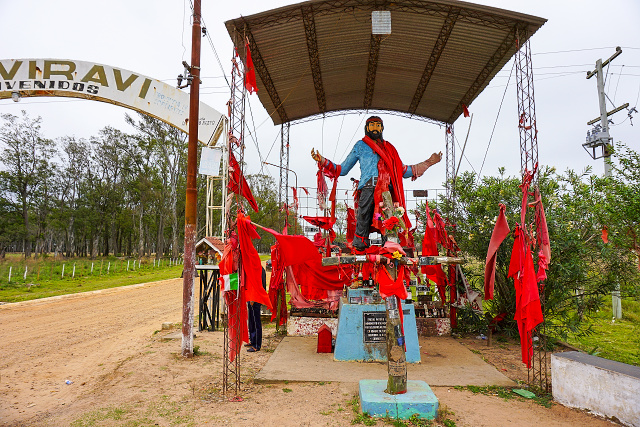
Guaviravi: Driving into town with widely venerated statue of the unholy Gauchito Gill
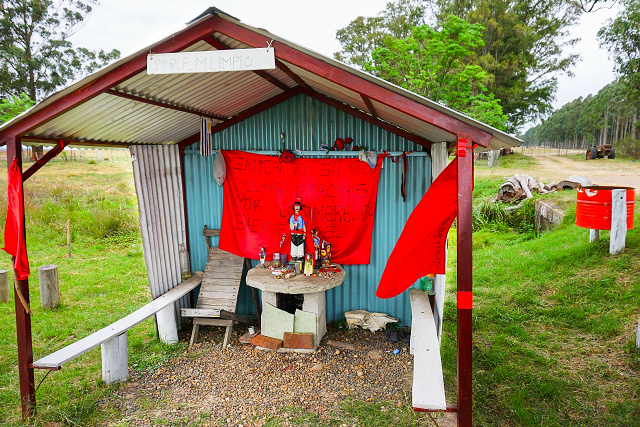
Tapebicuá: Chapel dedicated to Argentinean Robin Hood – Gauchito Gill

Tapebicuá: Wine (boxed wine is sufficient), brandy and cigarettes are placed in chapels so that Gauchito Gill does not suffer
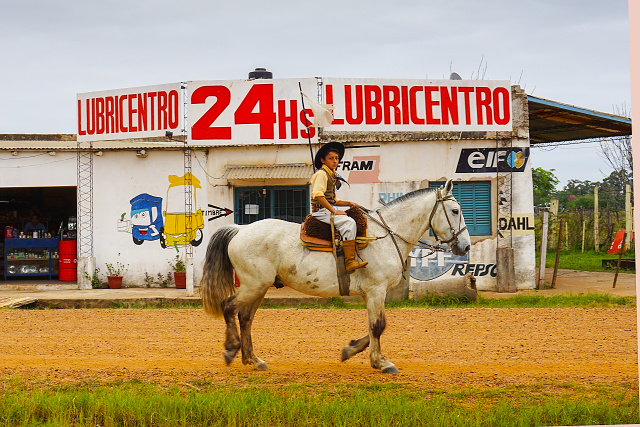
Paso de Los Libres: Horseman
I finished the longest route of that year – 120 km, still quite fresh. I purchased a lot of food in a store. The following day, I planned to take it through Brazil to Uruguay. I was unsure whether I could make it in one day, I did not want to change money to the Brazilian currency. So I planned to have a good stash of food and would sleep in the tent if necessary.

Paso de Los Libres: Local cathedral
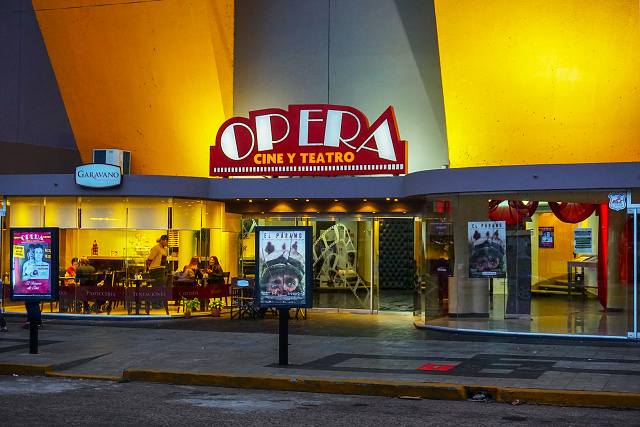
Paso de Los Libres: Cinema on the square, in contrast to the neglected area
I connected to the Internet and searched for possible solutions for my broken Kindle. The source of the problem seemed to be known: badly written Java Scripts on websites. They run in a loop, allocate all the memory, the screen becomes white and does not react to anything. The solution was easy – press and hold the 'on' switch for 40 seconds – it needed to be exact – and then release it. I did it, no sign of improvement, the light under the switch was still off. Five minutes later, the home screen came up, a growing indicator was displayed for some minutes and Kindle was once again alive. No data were lost, I was ecstatic. So I put aside the Mate I had been drinking and drank a glass of red wine instead. By the way, I had not consumed even a sip of beer for two days! The heat had decreased a bit and thirst could be quenched by Mate, which I prepared in a liter Nalgene bottle. Boiling water was often freely available in public places.
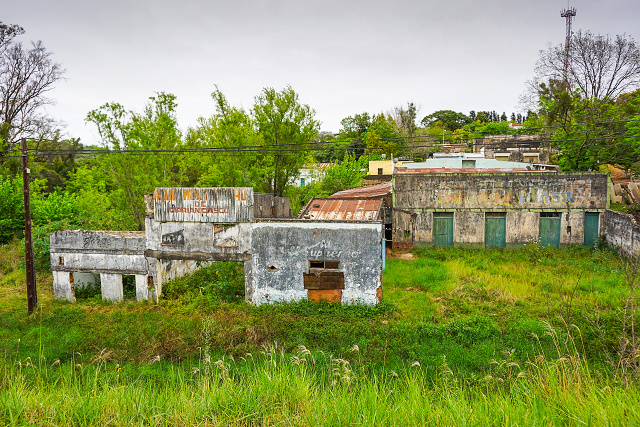
Paso de Los Libres: Houses a short distance from the Rio Uruguay border river - still on Argentine bank
Through Rainy Brazil
It was several kilometers to the border bridge. I found the passport office, which was hardly used there, as the locals have something similar to our Schengen. The passport control officer requested that I take off my helmet and scarf, so he could recognize me. I smiled at him, he was happy and I received the stamp immediately. I headed towards the gates of the bridge and a fully armed soldier jumped out from nowhere to stop me. After a short conversation, I understood that the bridge could not be crossed either by bike or on foot.
I returned to the border, even though I was already "checked in" and searched for a way of crossing the bridge. I learned at the bus stop that a bus would arrive "maòana", as that day was a Sunday. Sunday morning did not promise many cars which I could try to hitch a ride with. I finally stopped a taxi driver, who asked for a monstrous amount, but I bargained it down to the lower, still exorbitant price of 150 pesos (approx. CZK 400, $20). We then had to work hard to get the bicycle into the taxi somehow. It was an old Gol Combi (the local name for VW Golf), but without the foldable back seats. Finally, we pushed it all in somehow and entered the 4 km long route to the Brazilian passport control.
Schengen did not work quite as well in Brazil and Argentinians had to check in with their IDs at the border control and receive a stamped paper for entry into the country. I was unlucky, there was a whole busload in front of me, at least it was full of young ladies. The passport controller was genuinely interested in cyclotourism. He even stepped out of his office to check out my bicycle. I confirmed that it was possible to enter Uruguay at Quarai.
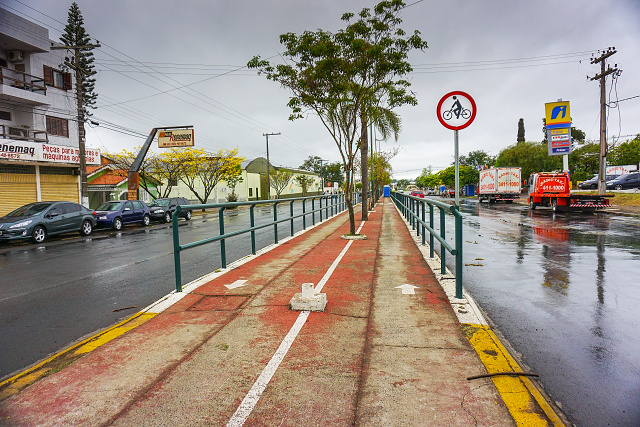
Uruguaiana: Cycle path in middle of the road
Meanwhile, it started to rain heavily. I went to the center to find an Exchange office in order to exchange some of the Argentinian pesos for Uruguayan cash. I was not interested in the Brazilian currency. However, nothing was open on a Sunday. But at least I got to see the festive procession of horses in the city center. We greeted each other enthusiastically – curiosities attract each other.
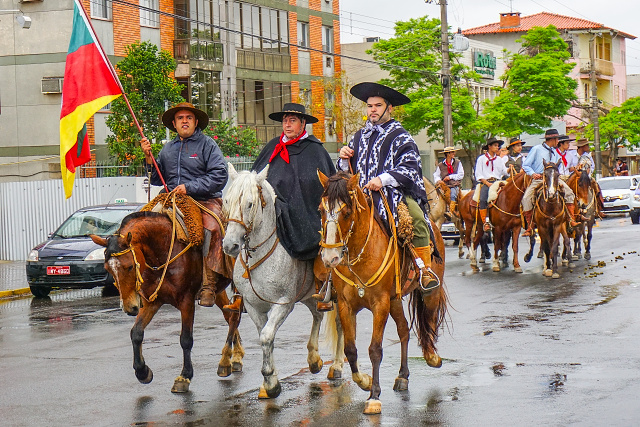
Uruguaiana: Sunday riders - some are very dignified

Uruguaiana: Riders greeting me enthusiastically
I easily found Road 290 to Porto Alegre, but it was damaged, potholes, bumpy side lanes with gravel and partly overgrown by grass. It was raining cats and dogs, a strong headwind blowing right into my face, steep – although short – hills. I cursed the "terrible wind, terrible road, terrible rain." In other words, I had fun... The headwind was so powerful that I had to strain myself in order to do at least 14 kph on the flat sections. It seemed that it would continue like that all the way to the Atlantic Ocean. At least I would get physically and mentally stronger.

30 km N of Quaraí: Landscape along road to Quaraí
It became obvious that I would not make the 130 km to Quaraí that day. After 80 km, I exited Road 290 to take Road 377 towards Quaraí. The wind blew from 9 o´clock and I felt notably better. However, it was already evening and so, when I had 90 km, I had to start looking for a place to sleep anyway. The pastures around were fenced off, next to the road was a several meter wide strip. I had to find a slightly flat place, without big stones, and which would at least partly shield me from the road view. I was pressed for time, as it had started raining again. In the end, I found a relatively well hidden, yet bumpy spot. For dinner, I had a baguette which I had foresightedly prepared. I lay down at 19:30 and fell asleep at 20:00 and slept for a decent 10 hours. It rained heavily again during the night, then it started to storm and the thunder and lightning kept waking me up. The tent remained dry inside, so I was not worried. I left the panniers on the bicycle, Ortlieb manages rain well.
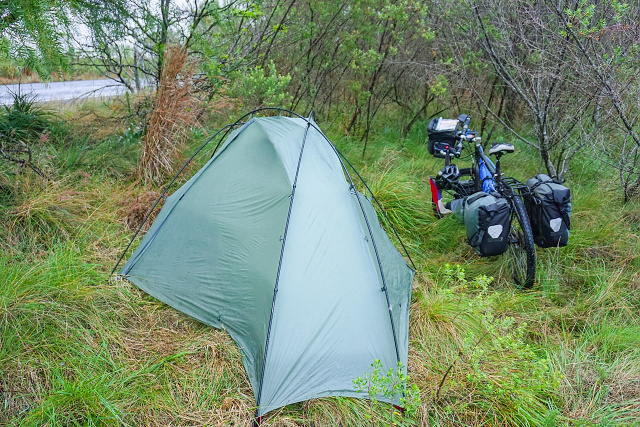
25 km N of Quaraí: I made my bed beside the road, I was fairly concealed
The following morning, I took advantage of a short break in the rain, packed up the tent which was wet on the outside and which of course got wet inside too after packing it up. If the fly-sheet had been separable, I could have packed the inner part separately, as I had done with Jurek tents. The weather was again getting worse, clouds low on the ground, mist on my glasses and rear-view mirrors. Luckily there were not many cars on the road.

15 km N of Quaraí: The overcast morning – dull, clouds reaching almost to the ground
After 15 km, I was so hungry that I ate all my food reserves. I had too little water, I was hydrated by a big juicy tomato. I passed through the Brazilian Quaraí towards the bridge and for a short while searched for the passport control. The Brazilian officer found the entry stamp from the previous day in my passport. Everything was clear to him, and he immediately stamped the next one. At the window next to his was the Uruguayan immigration. The boy informed me that he had a great rifle from the Czech Republic, from Berno (he meant the Czech Zbrojovka in Brno). I expanded his horizons to inform him that Pilsen, the name of the beer which was very popular in that region, was the name of a Czech city. Then he took about 20 minutes, even called the station manager, and I finally received the requested entry stamp. Eventually, he wanted a photograph taken with me, so I did not resist.

Quaraí: Souvenir photo with passport officer
The short bridge over Rio Quaraí was not restricted in any way. Everything was possible on foot, by bicycle, car or horses. Five minutes later, I was welcomed at the gates to Uruguay.
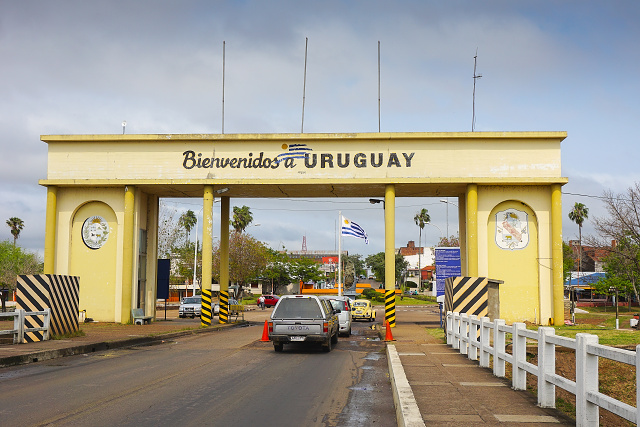
Artigas: Entry into Uruguay
